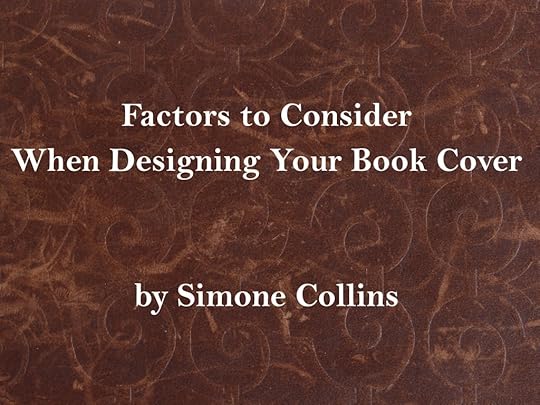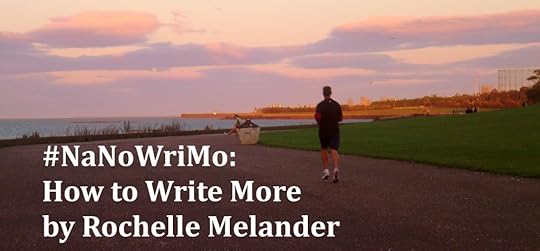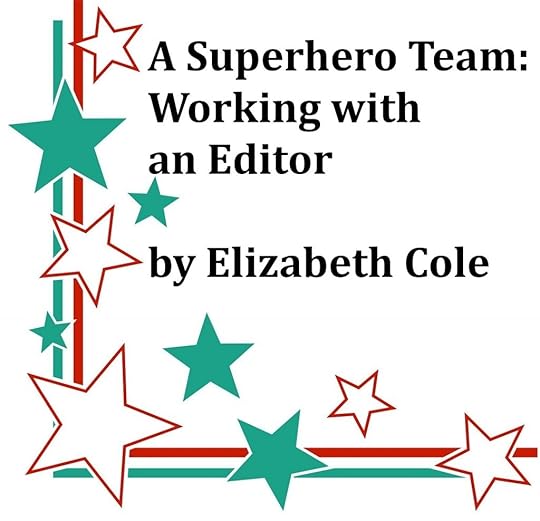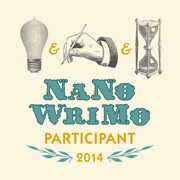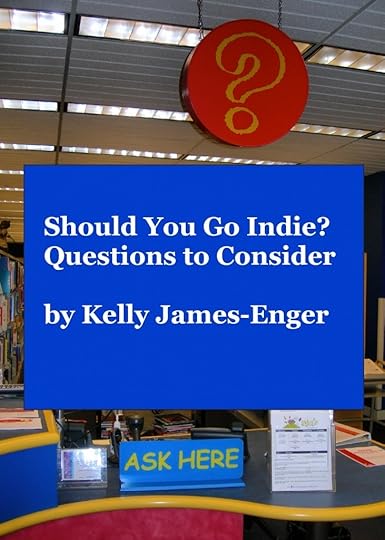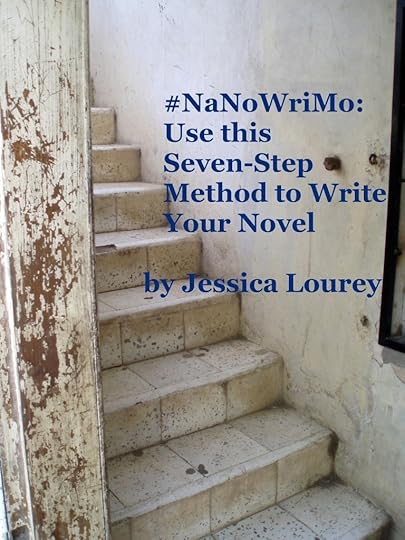Rochelle Melander's Blog, page 8
December 2, 2014
Factors to Consider When Designing Your Book Cover By Simone Collins
Dear Writers,
Welcome to December. I hope that in between the turkey, pie, and shopping sprees, you’ve been taking time to write. If not, there’s no better time to start than right now!
Today we continue our Indie publishing series with a tip by the wonderful Simone Collins on what to consider when designing your book cover.
Happy Writing! Rochelle, the Write Now! Coach
I run ArtCorgi.com, an online marketplace that makes it easy to commission made-to-order art from up-and-coming artists. Through one of our targeted storefronts, ArtforAuthors.com, I work with authors to have book covers (as well as author portraits, illustrations, and marketing graphics) designed.
Designing a book cover is a challenging process, even when you are working with an experienced and talented artist. No matter how talented your artist, photographer, or designer is, it is up to you what ultimately appears on the cover of your book. Here are key factors to consider when providing direction to those helping you craft your cover.
What Subjects and Designs Work for Books in my Genre? Before committing to any particular concept or layout, peruse the competition. Have a look at the covers of other books in your genre that are vying for readers’ attention. Find trends and determine common factors that appear to drive interest.
For example, a quick glance at books categorized as romantic comedies on Amazon.com suggests that optimal book covers feature photographs of couples’ faces (in the midst of various romantic acts), legs, feet next to each other, and headless bodies in various states of undress.
On the other hand, a look at science fiction books reveals more illustration, with a heavy emphasis on space, post-apocalyptic landscapes, and space ships.
What Will Make My Book Stand Out? I do not recommend simply going along with whatever seems to be popular in terms of book cover design for your genre. Though it can help to know what sort of imagery readers are attracted to, you should also think carefully about how you can stand out. After all, how will you break through as a romance novelist if your book cover shows yet another pair of nicely-shaven female legs placed alongside a pleasant setting?
Consider ways in which you can play up popular book cover themes while also inserting surprising elements and twists. Maybe your romance novel cover will feature legs, but perhaps they will be hanging out of a ship’s porthole or covered in tattoos.
What Will Make My Book Alluring? In addition to making your book cover design different from its competition, think carefully about how you can work in an element of mystery or pose an unanswered question. People are more likely to click through links to articles, books, and videos that pique their curiosity.
You may, for example, have the ‘token spaceship’ of your science fiction novel’s cover floundering on the floor of a public bathroom, tipped on its side like a discarded toy. Wouldn’t you be drawn to that cover after seeing a page full of space ship illustrations in which every single ship is floating through space or a post-apocalyptic / futuristic world?
Obviously you would want any burning questions elicited by your book’s cover to be tied to its story, but you catch my drift.
Will My Design Be Visible in Thumbnail Form? While considering how your book might stand out and be alluring in online listings, you should also contemplate how it will come across in thumbnail form. With mobile browsing on the rise, people are seeing smaller and smaller versions of links and products. If your book cover isn’t easy to discern in a small format, it is less likely to catch potential readers’ attention.
Make sure your design is simple and bold enough to be recognizable even when it is shrunk down to the size of a quarter.
What Represents Me as an Author? Do not forget that versions of your cover art will probably be adapted into marketing materials, social media cover photos and images, and promotional posters. People will use your cover design in reviews and promotional posts. People will judge your character and personality as an author by your book’s cover more than they will by its actual content (think about it- far more people will ultimately see a book’s cover than go so far as to read its first paragraph).
It is imperative that your book cover therefore be something that you are proud of. Something that represents your personal aesthetic and values. Something you would be happy to stand next to and smile with in countless photos. Sure, you can always change your cover art down the line, but it pays to get it right the first time.
 About the author. Simone Collins is the co-founder and CEO of ArtCorgi.com, an online marketplace that makes it easy to commission made-to-order art from up-and-coming artists. Before kicking off her own company, Simone worked as Director of Marketing at HubPages, one of the world’s largest publishing platforms for authors and freelance writers.
About the author. Simone Collins is the co-founder and CEO of ArtCorgi.com, an online marketplace that makes it easy to commission made-to-order art from up-and-coming artists. Before kicking off her own company, Simone worked as Director of Marketing at HubPages, one of the world’s largest publishing platforms for authors and freelance writers.
November 25, 2014
#NaNoWriMo: How to Write More by Rochelle Melander
When we commit ourselves to writing for some part of each day we are happier, more enlightened, alive, lighthearted and generous to everyone else. Even our health improves. –Brenda Ueland
I headed into National Novel Writing Month knowing that I probably wouldn’t finish. But I wanted to tap into the energy of the month to get a good head start on my next book project.

Post-race cheering with daughter Elly!
I had a similar goal last winter when I signed up for my first 5K: I wanted to run more. I knew that training for a race would help me do that.
Running experts talk about the 10 percent rule: increase your mileage by just 10 percent a week in order to remain injury free. Why? Because most running injuries come from overuse—doing too much, too fast. Then I found an interesting article by Matt Frazier, Rethinking the 10 Percent Rule for Increasing Mileage. Frazier experimented with a new training schedule:
Run every day.
Start with just 20 minutes every day.
Each week, increase the length of the run by 10 minutes.
Do less when you need to, but not more.
So what does this have to do with writing? Frazier’s plan for running training works for writers as well. We could create a similar writing plan:
Write every day.
Start with just 20 minutes a day.
Each week, increase your writing time by 10 minutes.
If you need to, do less. Skip a day. But don’t do more.
As National Novel Writing Month wraps up, many of us still have projects to complete (or start). Frazier’s plan of tiny steps—just 20 minutes a day—can help us start and finish our next writing project.
November 18, 2014
A Superhero Team: Working with an Editor by Elizabeth Cole
Dear Writers,
Last Tuesday at the library, I had 16 young novelists (ages 6-13) working hard on their novels. Most of the students were just beginning to tell their stories. But a few of the students had finished a first draft—remember young NaNoWriMo participants don’t have to write 50,000 words—and were thinking about revising.
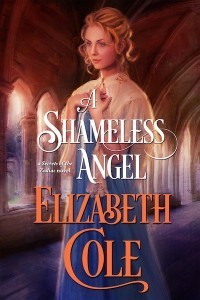 Over the years, I’ve had the pleasure of working with many gifted editors. They’ve taught me that the right editor can support writers in making a book better. And what writer doesn’t want that? Today’s guest post from author Elizabeth Cole demystifies the different types of editing and shows her editing process from beginning to end. If you hope that manuscript you’re writing will one day become a book that strangers read, you’ll want to check out what Cole has to say!
Over the years, I’ve had the pleasure of working with many gifted editors. They’ve taught me that the right editor can support writers in making a book better. And what writer doesn’t want that? Today’s guest post from author Elizabeth Cole demystifies the different types of editing and shows her editing process from beginning to end. If you hope that manuscript you’re writing will one day become a book that strangers read, you’ll want to check out what Cole has to say!
Happy Writing! Rochelle, the Write Now! Coach
Whether you are following a traditional or indie publishing route, before you actually publish your manuscript, you’ll be working with an editor. It might be someone assigned by your publisher, or it might be a freelance editor you’ve found on your own. Yes, they do cost money. That’s because they add value to your work. If you want a good product, you need to invest in it. That includes not only the time you put into writing it, but also the money to pay professionals to get the final package ready. Editing is part of that package.
There are different types of editing, all with different rates and goals.
*Proofreading is the most basic type. Proofreaders check spelling, make sure you didn’t use discreet when you meant discrete, and put all your commas in the right place. And that’s it.
*Copyediting is the next step up in complexity. A copyeditor actually reads the piece for coherency and logic. A copyeditor will tell you when Parvati’s pants change from blue to orange in the same scene, or that Emmy was super mean to your protagonist in the beginning, but then becomes besties with her in the next chapter with no explanation.
*Developmental editing is even more high-level. A developmental editor will read your story multiple times to examine how the plot arcs and how the themes are fitting in. He’ll tell you that the mood of the story waffles from comic to dark and back, but maybe not in the way it should. He’ll offer different ideas for fixing larger-scope problems in your manuscript.
*Many editors end up doing a mix of these roles, and charge accordingly.
Got all that? Great. Now we can talk about actually working with your editor. The writer and editor work as a team. An editor is neither a slave nor a genie. They’re professional contractors hired to make your work the best it can be. You must work with them.
Now, those categories I just mentioned? They’re actually listed backwards. In most cases, you’ll want to handle developmental editing first, then copyediting, than finally proofreading. Of course, the writer/editor work relationship is going to be unique for everyone. Your project is one of a kind, right? So I’ll just describe my own process to show you one method.
First, I spend a chunk of time working on the first draft of a novel. Personally, I don’t like showing parts of a draft to anyone, and I don’t like soliciting feedback until the first draft is done (that means no missing sections, no internal notes to self, no “ADD SOME PLOT HERE” messages, etc.). I want to hand off a piece that is readable by someone who has no info beforehand. That way, it most directly reflects the typical reader experience.
I self-edit the whole piece for coherency, and do a basic proofread and spellcheck. Then, I send copies to both my editor and beta readers (Ideally, you’d do beta readers first, but so often time does not allow for that extra month or two to send a novel out and wait for responses from the slowest readers. Functionally, it works just fine to do it all at once. I incorporate beta reader feedback into the second draft just as I do my editor’s feedback).
My editor does a first pass of the novel draft. She will note typos, change minor words or phrases if they’re awkward, and make lots of comments. All of these things happen digitally, I should add. No paper is printed or sent at any point in the process. I never meet with my editor in person as part of the process. Occasionally, we have a phone call to talk about story things that require a back-and-forth. But most of the process is online. We use the track changes tool to add comments and questions. At this stage, her comments might be things like: “This seems out of character for your shy protagonist.” or “I’d like to see more about the dog after Chapter X. It drops out after that point.” or “You say he’s 35 years old here, but 33 in a previous chapter.” Basically, anything that needs clarification or a second look. Some things are easy to fix. Others require additional passages to be written, or scenes to move around a bit. I’ll spend a few days or a week on these items.
Then I send the clean second draft (i.e. with every single comment or change accepted or rejected) back to my editor. She reads it again. There are more comments and more changes, but with luck, they’re more fine-grained (word choice in a character’s speech, or emphasizing a mood or tone in one scene). I go through it once again, attacking each tag or yellow bubble. Sometimes I’ll send a quick email to my editor regarding a particular issue, but once I resolve everything, I send the file to my publisher to be formatted.
Once it is, I send that new file back to my editor once last time for the proofreading pass. (I also do another proof pass, and so does one other person.) A note about proofreading: you can never have too many eyes. Someone will always catch something that five other people missed. It doesn’t mean anyone is bad at their job. But when you have 100,000 words and tons of punctuation, typos will flourish. It’s just the nature of things. Fix them and move on.
After everyone has proofed the file and all the changes are made, the book is ready for the final stage. My publisher adds front and back matter, cover art, metadata, and such. Then—on publication day, which we hope has not been moved back because of deadlines getting missed—the book goes up for sale! Easy peasy, right?
Depending on type of work you’re doing, maybe you only need to send the piece to your editor once. Maybe you’ll have five passes. Every piece is unique. But if you’re a career writer like I am, you’ll be writing piece after piece, and soon you’ll develop a workflow with your editor. I’ve been lucky in that I’ve had the same reliable editor every time. If you aren’t satisfied with yours, go find a different one. (If you’re working with a publishing house, you can request a different one, though you have much less control in that situation.) Not everyone has a compatible working style, so don’t think of it as a failure. It’s just part of the process.
One thing is true no matter what: all writing requires editing. All. Don’t try to skip it, and don’t breeze through it. Quality editing will make your work better. It’s well worth the extra time and effort to get it right.
 About the author. Elizabeth Cole is a romance author with a penchant for history, which is why she lives in an old house in an old city. She can be found hanging around libraries and archives, or curled in a corner reading, cat on lap. She believes in love at first sight. Then again, she also believes that mac ‘n’ cheese is a healthy breakfast, so don’t trust her judgment on everything. Find out more about her work and get some free books at elizabethcole.co
About the author. Elizabeth Cole is a romance author with a penchant for history, which is why she lives in an old house in an old city. She can be found hanging around libraries and archives, or curled in a corner reading, cat on lap. She believes in love at first sight. Then again, she also believes that mac ‘n’ cheese is a healthy breakfast, so don’t trust her judgment on everything. Find out more about her work and get some free books at elizabethcole.co
November 11, 2014
Self-Publishing: Getting Your Book Into Readers’ Hands by Nikki Broadwell
Last weekend, as I attended a short retreat, I meant to focus on the speaker and the topic. Instead, I found myself planning the murder in my National Novel Writing Month mystery. I took this as a sign I was on the right track with my life—writing a mystery, that is. Not plotting murder!
This week’s tip comes from author and self-publisher Nikki Broadwell. She lays out for us what she did to figure out how to publish and distribute her books—reminding us that writing, publishing, and marketing your book is truly a process! And don’t forget to check out her first paragraph—she’s giving away her first book today and tomorrow only! (And for the rest of the month, you can get it for a reduced price.)
Happy Writing! Rochelle, the Write Now! Coach
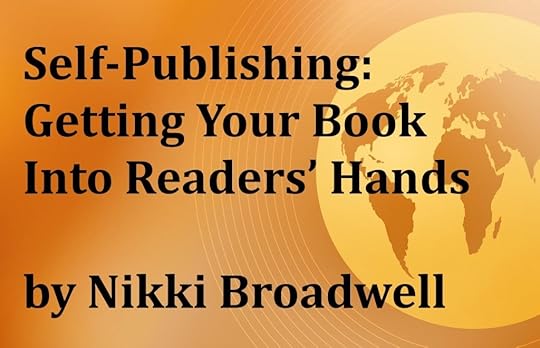 First of all, thank you to Rochelle Melander for giving me this opportunity!
First of all, thank you to Rochelle Melander for giving me this opportunity!
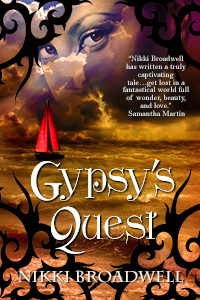 The electronic version of the first book of my Gypsy series, Gypsy’s Quest, will be free on Amazon the first two days of this blog post (November 11-12, 2014). And for the rest of the month of November both Gypsy’s Quest and Gypsy’s Return will be .99 in preparation for the release of Book 3, Gypsy’s Secret, which should arrive on Amazon in mid-December.
The electronic version of the first book of my Gypsy series, Gypsy’s Quest, will be free on Amazon the first two days of this blog post (November 11-12, 2014). And for the rest of the month of November both Gypsy’s Quest and Gypsy’s Return will be .99 in preparation for the release of Book 3, Gypsy’s Secret, which should arrive on Amazon in mid-December.
How I got started writing books
I’ve been writing full time for a little over twelve years now. My original plan was to write a sort of memoir about my parents’ life together. This fictionalized story, which is now 400 pages long, has been shelved. I began my first fantasy trilogy as a way to relieve the emotional stress of the memoir but what happened next was an utter surprise.
This fun story took off, and I seriously felt that someone else was writing it. By the time it was finished I had enough material for three books and so I divided it into a trilogy and rewrote a lot of it. After having two editors go though it, I sent it out to over 60 different agents, getting back nearly as many rejections. After a couple of years of this I gave up, deciding that I didn’t have enough time to wait around. And besides, I reasoned, if they did decide to pick it up, they would want to change it and it would take at least two years before it saw the light of day!
I’ve self-published six books since then and am about to release the seventh.
How I self published my books. After a lot of research by both my husband and myself, we chose CreateSpace as the best self-publishing option. We’d read good things, they were connected with Amazon, and their interface was the most straightforward by far. At first I had them do everything, from designing the cover, to formatting both the paperback and the kindle version. In the early days I didn’t know any better. Since then I’ve found a formatter, a cover designer and have saved myself oodles of money. Now when I send in the properly sized spine, I pay nothing for the privilege of having CreateSpace put it all together. All I pay for is my ISBN. My formatter Rik Hall sends me the e-version as well as the paperback PDF, and so it’s a simple process to set it up.
And then I learned about distribution. But there is one important point that I didn’t know. CreateSpace lists expanded distribution through Ingram, an option self-publishers can select once their book is up on the site. Ingram is one of the biggest wholesalers and as such has a great reputation. Unfortunately, there’s a problem. One of my book buyers told me he’d happily order my books, saving me the hassle of paying for them and having them shipped to me and then shipping them to him to be put on consignment. Bear with me on this next bit because I’m still sifting through it, but from what I’ve gleaned so far, the discount offered to bookstores through CreateSpace expanded distribution is not industry standard and on top of that, the POD versions cannot be returned. This poses a serious problem for bookstores.
For some reason my first two books came up on the computer at the small bookstore where my friend tried to order them. But the third did not. This is not explained by CreateSpace or by anyone else that I’ve spoken with.
And so I began to dig. First, I called Createspace and found that they could not or would not change the discount offered to bookstores. I then perused blogs that compared Createspace and Ingram publishing services. And from my reading it did sound as though Ingram was the better choice for print. I e-mailed back and forth with one man who had blogged about this and his recommendations was to do e-books through Createspace and the print books with Ingram.
The move to Ingram. I decided to move some of my newer titles to Ingram. After all how hard could it be, considering the books were already published? After spending $49 for each title and an extra $10 each for redoing the files, I was told I would need to hire a designer. For some reason, one of my titles made it through this process. It had the same formatter and the same cover designer. The only difference was that I had purchased the ISBN directly through Bowker instead of opting for the $10 version offered on CreateSpace. (There’s a free option as well) On the other two titles, I replaced the Createspace ISBN’s with new ones, another outlay of $27 for each title.
I know all of this sounds impossibly complicated and I hope it makes some sense to those of you starting out. What I have now learned is that Ingram has several self-publishing options, and they are NOT created equally. Apparently, in order to get their true expanded distribution one has to publish through Ingram Publishing instead of IngramSpark or Lightning Source. But when I contacted them I was sent back to IngramSpark. So now I have one paperback book listed with Ingram and I doubt very much that the bother of getting it there has done anything for me. I also paid $60 to promote this title. Has this helped? I have no idea.
Ingram’s interface is not as easy as CreateSpace, nor is the ability to contact them. My recommendation for the new author coming into the marketplace is to do your homework and weigh your options. Will you mostly be selling e-books or is it important to have your books listed on the computer when someone searches for them in a bookstore? With all the marketing decisions and everything else that goes into it, self-publishing is not for the faint-hearted. But, for me, it’s been both easy and inexpensive, a step up from the gatekeepers who refuse to even look at one’s work.
As self-publishers, we are stuck with this distribution problem until someone comes up with a better way. This Shewrites article goes one step further to explain it.
Your turn: What worked for you?
 About the author. Nikki was already the mother of two girls when she graduated from Sonoma State University with a degree in Art. After running two successful businesses—creating greeting cards and silk painted scarves and wallhangings—Nikki began writing books. Nikki now lives in Tucson, Arizona with her husband of over thirty years, a standard poodle, Buddha, and Eesa, the cat. She is currently finishing up the third book of a time-traveling trilogy, Gypsy’s Secret. When not writing, Nikki travels, does yoga, hikes, and gardens and watches the bird and animal life that abound in the desert.
About the author. Nikki was already the mother of two girls when she graduated from Sonoma State University with a degree in Art. After running two successful businesses—creating greeting cards and silk painted scarves and wallhangings—Nikki began writing books. Nikki now lives in Tucson, Arizona with her husband of over thirty years, a standard poodle, Buddha, and Eesa, the cat. She is currently finishing up the third book of a time-traveling trilogy, Gypsy’s Secret. When not writing, Nikki travels, does yoga, hikes, and gardens and watches the bird and animal life that abound in the desert.
Connect with Nikki online
http://niksblog-authorinprogress.blogspot.com
https://twitter.com/nikkibroadwell
November 4, 2014
Should You Go #Indie? Questions to Consider By Kelly James-Enger
Dear Writers,
Many of you have started your National Novel Writing Month projects! Congrats and good luck!
This month and next, as I hunker down to write my novel, I’ve organized a series of wonderful guest posts on indie publishing. I’ve invited writers and publishing professionals to help you learn. Today, I welcome the amazing Kelly James-Enger who reflects on the question, Should You Go Indie?
Happy Writing! Rochelle, the Write Now! Coach
Technology has changed the publishing landscape, giving would-be authors more opportunities than before. You needn’t pursue a traditional publisher; now you can use a print-on-demand, or POD, company to get your book in print, or choose a third option—starting your own indie publishing company.
But before you do so, it’s smart to ask yourself some critical questions, like the following:
How much experience do you have? The more you know about publishing, the better. I’d published books with both traditional and print-on-demand publishers before I even considered launching my own press. And yet the learning curve was still steep when I founded Improvise Press last year; I spent about six months lining up everything I needed to turn two finished manuscripts into actual books.
How will you connect with your audience? A traditional publisher may not do a lot to market your book, but it has an easier time getting it into the bookstore. When you have your own press, you need to act as your own distributor, or hire a distributor. The former is time-consuming; the latter is expensive. If you connect with your readers directly—for example, you have a strong social media presence—you’ll have an easier time as an indie publisher.
How much time are you willing to commit? Trust me, everything will take longer than you expected, or planned. First you write the book. Then you must edit and proofread it, or hire someone to do that for you. You’ll also need a cover designer; an interior layout designer; and someone to write the cover copy on the book cover or jacket itself. And that’s just the beginning. You still have to have distribute, market, promote, and sell the book—or hire someone else to do it.
How much marketing experience do you have? Any author will tell you that writing the book is the easy part; actually selling the book is the most time-consuming part. If you’ve marketed other books before, it’s a huge help as an indie publisher. Otherwise you can plan to spend money hiring someone to market your book for you.
How much money are you willing to spend? You can launch an indie company on a shoestring, but most people spend more than that. I spent about $4000 (including 100 copies of each of the press’ first two titles so I had them available to sell) to launch Improvise Press; I’m still operating in the red. Would I do it again? Ask me in a year or so when I hope to be turning a profit.
How realistic are your expectations? I planned to sell at least 2,000 copies of my IP titles in the first quarter; actual sales were just over a tenth of that. Since then, I’ve been selling 30-40 copies (including electronic versions) of IP titles each month. I average about $5/copy (that includes print and electronic editions), so when you do the math, you can see that it will take time to make that money back. If you think going indie ensures thousands of sales, you may want to check your thinking.
How committed are you? Starting an indie press takes time, and when your profit per-book is only a few dollars, it also takes time to make a profit. If you decide to go indie, plan to commit time every week to continuing to promote your books and your company—and you have to be willing to do that for the long haul.
There are no right or wrong answers to these questions; some book authors thrive as indie press owners and others prefer to stay traditional or POD (or a mix of both). Being honest about your expectations and your abilities will help you make the right choice that best fits you, and your books.
Your turn: What’s your experience with going indie?
 About the author. Kelly James-Enger is the owner of Improvise Press; she’s also the author of books including Goodbye Byline, Hello Big Bucks: Make Money Ghostwriting Books, Articles, Blogs and More, Second Edition. She blogs about making more money in less time at http://dollarsanddeadlines.blogspot.com.
About the author. Kelly James-Enger is the owner of Improvise Press; she’s also the author of books including Goodbye Byline, Hello Big Bucks: Make Money Ghostwriting Books, Articles, Blogs and More, Second Edition. She blogs about making more money in less time at http://dollarsanddeadlines.blogspot.com.
October 28, 2014
#NaNoWriMo: Use this Seven-Step Method to Write Your Novel by Jessica Lourey
I can’t believe it: National Novel Writing Month starts Saturday. And if you’re way behind in planning, I have a treat for you. For today’s tip, I’m featuring an article by acclaimed mystery novelist Jessica Lourey that will give you everything you need to plan your novel for November. And if you’re in the Milwaukee area, she’ll be appearing at Murder and Mayhem this coming Saturday, November 1, 2014.
Happy Writing! Rochelle, the Write Now! Coach
I’ve got a great idea for a novel—it’s a heart-pounding adventure and the main character is young, she’s on a mirror planet where she possesses magical powers, and she’s a hamster.
This is a snippet from a conversation I had with a guest at a recent book signing. As our chat continued, it became clear that he was passionate about his hamster adventure and had devoted many brain-hours to fleshing it out. “How far along is it?” I asked. “What?” “Your novel,” I said. “How many pages have you typed?” “Oh, I’m no writer, as much as I’d like to be. I just come up with the ideas. That’s the hard part, right?”
While there are a lot of things wrong with this conversation (start with “hamster adventure” and work your way to “That’s the hard part, right?”), the one that stuck with me was this: “I’m no writer.” This fellow was so juiced about his concept that he shared it with perfect strangers, yet he had no idea how to translate it into a novel.
I can’t tell you how many people just like him I’ve encountered on book tours and in my classroom. These are people who dream of turning their unique idea into a book but are too intimidated by the process to take that first step. Or, they start writing and soon become overwhelmed and demoralized.
I’m here with some good news: Writing a novel is a process you can navigate. I’ve created a writing pyramid that illustrates how to plot your path, guiding you from a crucial one-sentence summary of your book (the base of the pyramid) to progressively higher levels until you’ve created a finished manuscript.
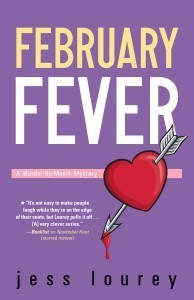 I’ve used this approach to develop my critically acclaimed six-novel Murder-by-Month mystery series from Midnight Ink, so I know it works. If you’ve got a great idea and you’re ready to turn that spark into a full-fledged novel, all you have to do is carve out some time and follow these seven straightforward steps.
I’ve used this approach to develop my critically acclaimed six-novel Murder-by-Month mystery series from Midnight Ink, so I know it works. If you’ve got a great idea and you’re ready to turn that spark into a full-fledged novel, all you have to do is carve out some time and follow these seven straightforward steps.
1. Summarize your novel in one sentence.
Begin the process by distilling your idea into its purest form. Don’t include specific names or places now; the idea is to be purely conceptual. Here’s an example of a one-sentence summary for H.G. Wells’ classic novel The Time Machine: An English inventor travels thousands of years into the future, discovering the devolution of humanity where he had hoped to find utopia. It’s tempting to pack lots of detail into the one-sentence summary. Your idea is complex, your characters multifaceted, your setting diverse. How can you condense all of that to a handful of words? I know the challenge. Here is my first attempt at crafting a guiding one sentence summary for November Storm, the novel I’m now writing for my series:
Mira James, a new PI license and copy of Private Investigation for Dummies in hand, is asked to look into a suspicious hunting accident in northern Minnesota and instead uncovers a secret that threatens to topple the community. Meanwhile, another dead body is thrown into her path, and she is forced to juggle a budding relationship with blue-eyed Johnny Leeson with an uncomfortable attraction to Gary Wohnt, local police chief, while her kinetic sidekick, Mrs. Berns, flies the coop, leaving Mira to work it out on her own.
Besides being one sentence too long, this summary includes extraneous detail that is important to me but not crucial to the task. Again, the goal of Step 1 in the writing pyramid is to take an aerial snapshot of your novel, capturing only the large structure. So, after I cut away the subplots, supporting characters, and superficial detail, I was left with this summary of November Storm:
A newly minted Minnesota PI investigates a suspicious hunting accident, uncovering a brutal small-town secret.
If you craft this sentence well, it will not only give your entire writing process a boost, but you’ll have a powerful selling line to use with a future agent or potential reader.
2. Now expand your one-sentence summary into a full paragraph. Include the status quo at the beginning of the novel, what obstacles the protagonist encounters, and how the novel ends. This isn’t the time for secrets. Lay it all out. If it is helpful, freewrite or mindmap, using key names or phrases from your Step 1 summary as your launch point. Based on my one-sentence summary of The Time Machine, for example, I would use “English inventor,” “thousands of years into the future,” and/or “devolution of humanity.” Here is that single sentence summary expanded into a full paragraph (note: spoiler alert in case you’re planning to read his novel!):
The book opens with the Time Traveler dining with peers in late 1800s England, where he is trying to convince them that he’s invented a time machine. His guests are naturally skeptical. They arrange to dine again in a week, and when they return, the Time Traveler tells them he’s visited the future. He discovered two humanoid races remaining on the planet: the beautiful and childlike Eloi, and the subterranean, haunted Morlocks. He explains his idyllic time eating fruit with the Elois and exploring the area, followed by his discovery that the Morlocks raise and harvest the Eloi like cattle. He ends by describing his escape from the time period, including his burning of the forest, the wresting of his time machine from the Morlocks, and the loss of Weena, his Eloi friend. Distraught, he travels further into the future where he witnesses the death of humanity and the planet. Finally, he returns to the time period he left, providing an exotic flower from Weena as proof of his travels.
Note that the ending must be given away to make this paragraph work. This summary is for your eyes only, and it’s dynamic. You’ll find yourself returning to tweak it as you continue up the writing pyramid, and that’s OK. Revising as new ideas occur is one of the exciting elements of writing.
3. Invite your characters in. So: You’ve taken a snapshot of your novel’s point and created a rudimentary outline of how to get there. Now is the time to create a sourcebook, or character bible, for profiling each of your significant characters. I handwrite my character bibles, but a computer works just as well. Devote at least a page to each character. Include the following information:
Name and photograph. The photo is optional, but if you come across a picture of someone in a magazine or newspaper, or an old family photograph that reminds you of your character, slipping that photo into the character’s page is an effective way to spur creativity and flesh out characterization. For example, I have a photo of actress Betty White in the character page for Mrs. Berns, the wonderfully spicy octogenarian who regularly appears in my series. Physical characteristics. This includes the basics of height, weight, hair and eye color, etc. Age. Include the actual birth date if it’s relevant.
Personality traits and their source. For example, is the character lazy because her mother always picked up after her? Does he love baseball because it’s the only game his father ever played with him?
Quirks. These are one or two imperfections that make your character human, such as a tendency to hum when nervous.
Goals and motivation. Ask yourself what your character wants and why he or she wants it.
Conflict. List the obstacles, large and small, that the character faces in achieving his or her goals.
Growth. How is this character going to be different at the end of this novel than at the beginning?
General story line. Draft a three to five-sentence summary of the character’s story arc; this will be a character specific version of the novel summary you wrote in Step 2. Remember that you as the author always need to know more about your characters than your reader ever sees. This inside information allows you to create a multi-dimensional, internally consistent population for your novel.
Beware that Step 3 is an easy place to get sidetracked; keep your character outlines to one page per person so the process doesn’t morph from novel writing to scrapbooking.
4. Sketch your setting. If you don’t yet have a notebook for your novel, buy one. You want to physically draw the neighborhood(s) and the interior space(s) where most of your story will take place. No fear—you don’t need to be an artist to do this. If you’re sketching a room, for example, just chicken-scratch the major pieces of furniture and placement of windows and doors, as well as which direction is north. If your book is set mostly in a neighborhood or town, sketch out the relevant cross streets and put labeled boxes where you imagine all the businesses and houses would be.
The setting sketches anchor your writing and allow you to maintain congruity in your place descriptions. If you have space, staple in a photo or two if you come across an image that visually captures an element of your setting.
5. Develop each sentence in Step 2 into a full-page description.
Include at least two sound, two smell, and two feel details on each page. For example, let’s take the first sentence of The Time Machine summary that I created in Step 2: The book opens with the Time Traveler dining with learned peers in late 1800s England, where he is trying to convince them that he has invented a time machine.
If I were to expand this to one page, I would describe the characters’ clothes, the smell and flavor of the food they’re eating, the feel of the tablecloth under their hands, the clank of the forks on their plates. I would include preliminary research into the political issues, mores, and scientific breakthroughs of England in the late 1800s so I could include accurate conversational topics and make sure I got the clothes and hairstyles correct. Specific to the topic of a time machine, I’d brainstorm and roughly outline the give-and-take that would occur if someone told me they’d invented a time machine. Do this for every sentence in Step 2.
6. Do a rough outline of the novel. Remember the words of Robert Frost: “No surprise in the writer, no surprise in the reader.” A chapter-by-chapter, detailed outline is laborious to craft and restricts the creative drive when it comes time to actually write the novel. I recommend instead generating a rough outline that highlights only the major conflicts and character interactions, essentially a more complex version of the summary you completed in Step 2. This “big picture” outline allows you to always have something exciting to write toward without eliminating the joy of discovering what your characters will do when left to their own devices.
7. Write the novel. This is it. The training wheels are off. You have a snapshot of your novel and a rough map for creating it. You know which characters you’re bringing in, what they’ll face, and in what locations they’ll face it. Start writing the story from the beginning, and don’t stop until you have a complete first draft. Writing a novel really is this straightforward when you break it into the seven manageable steps of the writing pyramid. Good luck! And if you see a hamster adventure tale on the bestseller list in a year or two, you’ll know who’s to blame.
 About the author. Jessica (Jess) Lourey is best known for her critically-acclaimed Murder-by-Month mysteries, which have earned multiple starred reviews from Library Journal and Booklist, the latter writing, her books are “a splendid mix of humor and suspense.” Jessica also writes sword and sorcery fantasy as Albert Lea and edge-of-your-seat YA adventure as J.H. Lourey, and is branching out into literary fiction, including magical realism, under her given name. You can check out her Kickstarter project to bring her latest book to a wide audience here.
About the author. Jessica (Jess) Lourey is best known for her critically-acclaimed Murder-by-Month mysteries, which have earned multiple starred reviews from Library Journal and Booklist, the latter writing, her books are “a splendid mix of humor and suspense.” Jessica also writes sword and sorcery fantasy as Albert Lea and edge-of-your-seat YA adventure as J.H. Lourey, and is branching out into literary fiction, including magical realism, under her given name. You can check out her Kickstarter project to bring her latest book to a wide audience here.
She is a tenured professor of creative writing and sociology at a Minnesota college. When not teaching, reading, traveling, writing, or raising her two wonderful kids, you can find her dreaming big, playing with her dorky dog, or watching craptastic SyFy original movies. Visit her website at www.jessicalourey.com or her Facebook page at https://www.facebook.com/jess.lourey
October 21, 2014
#NaNoWriMo Prep: Saying NO and Yes by Rochelle Melander
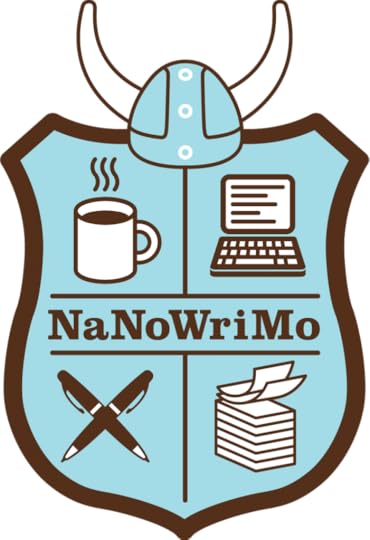
Image courtesy of National Novel Writing Month
I have a bad habit: saying yes. Sometimes I agree to do things—volunteer my time, write stuff, make food—and later regret it. When Brené Brown talks about setting boundaries, she uses this mantra: “Choose discomfort over resentment.” Wow. I love that! And I need it—especially if I plan to complete National Novel Writing Month this year!
Here’s the thing: I like saying yes. I like it when people approve of me. As you have probably noticed, the people who are asking you to do something LOVE it when you say yes. But we cannot say yes to everything everyone wants us to do and still show up for our writing.
We need to find a way to say yes to our writing and say no to the activities that tend to get in the way of writing. It’s been more than ten years since I first read about the absolute yes list in Cheryl Richardson’s book, Take Time For Your Life. Since then, I have used this tool to help me set and keep priorities.
An absolute yes list is simply a list of the five things in your life that you will always say yes to. My list is: self, family, friends, writing, and coaching work. For each of these items, I’ve made a list of the activities that tend to nourish me—like exercise, reading, seeing plays with friends, and writing books. When someone asks me to do something, I mentally check the list. If the task is not on the list, I usually choose not to do it.
Writers, if you are planning to do National Novel Writing Month, you need to make your list right now. If you are not doing NaNoWriMo, think about creating this list anyway. It will help you keep your priorities and write more.
So how does it work? Ask yourself: What five things are most important to me? List them. Under each item, add a few sentences to describe what you mean by “writing” or “family.” It is helpful to be specific here. For example, while family is definitely on my list, and part of that includes helping out at my children’s schools, I am clear that I want to help in ways that allow me to use my strengths. That means I rarely do administrative tasks but usually do teach a writing class or two a year.
Once you have made the list, orient your days around it. Eliminate the things that do not fit your plan. National Novel Writing Month is great because it gives you an excuse to take a month off from some of your regular activities. At the end of the month, you can decide whether or not you want to keep these commitments.
Why this works. Over the years, I have collected some thoughts and ideas about why an absolute yes list is a must. I cannot tell you where these come from or who said them first. I can tell you that these ideas have helped me to stick to my absolute yes list more often than not.
*How you live today is how you live your life.
*When you say YES to that which matters least, you are saying NO to what matters most. When you say yes to tiny tasks like constantly tweeting, you are saying no to being a writer.
*The things that matter most must never be at the mercy of the things that matter least. A simple example: the telemarketers calling you or texting you should never be more important than your work.
*What matters most to others might not matter most to you.
The absolute yes list is a simple tool to help you say no to the activities that distract you from writing. When you are asked to facilitate the neighborhood block party or join a new dinner club—you will look at your list and ask, “Is this event or task on my absolute yes list?” If not, you say no. No guilt. No angst. Not even an explanation. Just say no.
October 14, 2014
#NaNoWriMo Prep: The Book Hook by Rochelle Melander

Image courtesy of National Novel Writing Month
You’re at a networking event. (Maybe you’re an introverted writer who avoids any group gathering with strangers, but work with me here.) While chatting over wine and cheese, someone who knows you’re a writer asks you, “So what are you working on now?”
My advice? Make something up. Don’t ever tell people what you’re working on until you’ve finished it. It just raises expectations and makes you crazy, especially when you dump that idea in favor of something better but your great uncle keeps asking you, “Have you finished that book on the secret life of squirrels?”
That said, YOU need to know what you’re working on. Last week, you jotted down all of the features you love in a book. Once you’ve got that information, it’s time to pull them together into a book idea you will love working on. In order to gain clarity and focus, it’s helpful to prepare a book hook.
What it is: A short summary of your book that includes the genre, main character, and central conflict (fiction) or main problem and solution (nonfiction).
What it looks like: Here are three examples from the current New York Times bestseller list:
Gone Girl by Gillian Flynn. A woman disappears on the day of her fifth anniversary; is her husband a killer?
Personal by Lee Child. Jack Reacher, a former military cop, helps the State Department and the C.I.A. stop a sniper who has targeted a G8 summit.
Quiet by Susan Cain. Introverts — approximately one-third of the population — are undervalued in American society.
Why you need it:
While you are writing the book, your book hook will keep you focused. When you’re tempted to jump off onto yet another meandering tangent or subplot, you can look at the book hook and remember the central theme and purpose of your book.
After you’ve written the book, your book hook will help you sell it to editors, agents, booksellers, bloggers, and the rest of your adoring public.
How to create it:
Read. The best way to learn how to write book hooks is to read them. Look at book jacket copy, reviews, and author websites until you “get” the formula.
Know the key elements. Start by jotting down the key elements for your book hook. As you do so, remember you are writing this hook with your ideal reader in mind. What will he or she need to know?
If you’re a fiction writer, the key elements of a book hook include:
*type of book
*main character
*central conflict or quest of the book
*location
*era
If you’re writing a nonfiction book, your elements are:
*central problem the book addresses or teaches readers to overcome (perhaps with some anecdotal evidence or statistics to aid you in hooking the reader)
*the ideal reader (e.g., overworked parents who need help managing tasks and children)
*the solution (you don’t have to give it all away, but let us know what you’re providing—maybe a ten-step program to help people lose weight)
Write and Revise. Write a draft of your own book hook. Rewrite it. Play with word order and verb choices. After you have a draft you like, test it out on a few trusted people, like those in your critique group. Don’t worry if you have to rewrite it hundreds of times—the work will help you sharpen your understanding of both your book and how to sell it. A great hook gets used repeatedly throughout the life of a book—so it’s well worth the time and effort to get it right.
Next week: Tune in to find out how to turn your book hook into an outline!
October 7, 2014
#NaNoWriMo Prep: Write What You Seek by Rochelle Melander

Image courtesy of National Novel Writing Month
Write the book you want to read, the one you cannot find. —Carol Shields
About a year ago, Louise Penny came to Boswell Book Company to launch her mystery, How the Light Gets In, the ninth book in her wildly successful Inspector Armand Gamache series. She told us that after facing five years of writer’s block, she decided to write the books she’d love to read. Penny created a village that she’d love to live in, people she’d want to hang out with and Gamache, a man she’d want to marry. I often wonder if Louise Penny’s books are so successful because of her approach: create something she adored.
In November, many of you will once again take on the crazy, wild National Novel Writing Month challenge. Some of you will write a novel, while others will take the opportunity to finish that memoir or scribble your next self-help book. Whatever your goal, this month is a good time to plan your NaNoWriMo book or your next writing project. And here’s your first assignment:
Make a list of your 5-10 favorite books in the genre you plan to write in. Then, consider these questions:
+If these books are novels, what do you love about the:
*genre
*characters
*plot
*setting and time period
*writing style
*point of view
*voice
+If these books are nonfiction, what do you love about:
*the genre (self-help, essays, biography, etc.)
*the topic
*the structure
*the features (e.g., callouts, stories, questions for reflection, etc.)
*the voice
When I do this assignment before I work on a new book, it helps me plan a project I’m going to enjoy writing. I hope it’ll help you plan your NaNoWriMo project—or whatever sort of book you plan to write next.
Your turn: what helps you decide what kind of book to write next?
Write What You Seek by Rochelle Melander

Image courtesy of National Novel Writing Month
Write the book you want to read, the one you cannot find. —Carol Shields
About a year ago, Louise Penny came to Boswell Book Company to launch her mystery, How the Light Gets In, the ninth book in her wildly successful Inspector Armand Gamache series. She told us that after facing five years of writer’s block, she decided to write the books she’d love to read. Penny created a village that she’d love to live in, people she’d want to hang out with and Gamache, a man she’d want to marry. I often wonder if Louise Penny’s books are so successful because of her approach: create something she adored.
In November, many of you will once again take on the crazy, wild National Novel Writing Month challenge. Some of you will write a novel, while others will take the opportunity to finish that memoir or scribble your next self-help book. Whatever your goal, this month is a good time to plan your NaNoWriMo book or your next writing project. And here’s your first assignment:
Make a list of your 5-10 favorite books in the genre you plan to write in. Then, consider these questions:
+If these books are novels, what do you love about the:
*genre
*characters
*plot
*setting and time period
*writing style
*point of view
*voice
+If these books are nonfiction, what do you love about:
*the genre (self-help, essays, biography, etc.)
*the topic
*the structure
*the features (e.g., callouts, stories, questions for reflection, etc.)
*the voice
When I do this assignment before I work on a new book, it helps me plan a project I’m going to enjoy writing. I hope it’ll help you plan your NaNoWriMo project—or whatever sort of book you plan to write next.
Your turn: what helps you decide what kind of book to write next?

